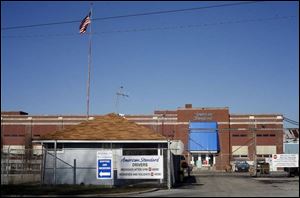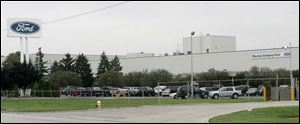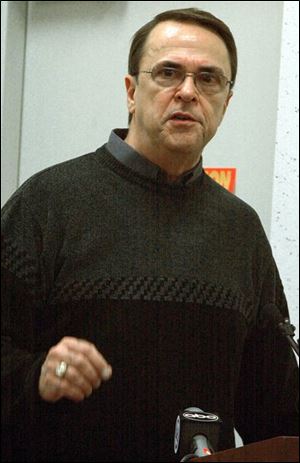
Manufacturing losses exact rising toll in northwest Ohio and southeast Michigan
7/27/2008
Mahaffey
black / blade
The pudding cups are gone.
So are the hot dogs, and bumper covers, and spark plugs.
Even the toilets in Tiffin have been flushed away.
Politicians rail against the loss of high-paying manufacturing jobs especially in their own constituencies but then say they are powerless to fight the global economy, or openly support policies that contributed to the job losses.
The latest large-scale casualty Norwalk Furniture Corp. in Huron County stunned its more than 500 employees with an immediate layoff notice on July 18 when its bank, Comerica of Dallas, abruptly cut off its credit.
State and local officials are trying to engineer a resurrection of the upscale furniture manufacturer, but whether Norwalk Furniture s shutdown is permanent remained a mystery to the plant s proud workers and city employees last week. On Friday, the company said Comerica has agreed to discuss a restructuring plan that would allow it to continue operations.
I wish I had better news, Norwalk Mayor Sue Lesch said. I wish I had a magic wand.
Since 1995, when the North American Free Trade Agreement took effect, Ohio has almost continuously shed manufacturing jobs, while losing ground overall to other states and regions.

American Standard announced in December it would close its toilet bowl factory in Tiffin. The plant closed in January.
Consider:
• Over the past five years, Ohio, Michigan, and Indiana posted the three lowest growth rates in gross domestic product among all states, according to the Northeast Midwest Institute.
• In 1990, Ohio had an average of 1,059,520 people employed in manufacturing, according to the U.S. Bureau of Labor Statistics. As of May, 2008, there were 762,200 persons working in manufacturing a loss of almost 300,000 good-paying jobs after years of steady decline.
• Ohio saw its gross domestic product grow by 15.9 percent between 2003 and 2007. In the same period, the national GDP average was 26.2 percent.
With America s economy in trouble, and potentially in recession, industries are facing a double whammy: consumers who can t afford to spend like they could two years ago and intense competition from foreign manufacturers offering low-cost products.
Possible culprits
Democrats and Republicans battling for control of the White House and Congress have staked out markedly different positions on why manufacturing is struggling and how to resolve it.
• An uneven playing field
U.S. Rep. Marcy Kaptur, a Democrat from Toledo who has represented Ohio s 9th Congressional District for more than two decades, said manufacturers in the United States are forced to compete on an uneven playing field in the world market.

The Ford Stamping Plant in Maumee closed in the fall of 2007. A group of investors wants to purchase and reopen the plant.
Essentially, American firms and the American people are being asked to compete against communist economies, managed economies, closed economies, and these create unbearable hardships, Miss Kaptur said.
She said other countries subsidize the health and pension costs shouldered by corporations here, adding thousands of dollars to a car s price, for example.
I would relieve the legacy costs on our manufacturers through tax policy, Miss Kaptur said. And while some would seek to characterize her stance as protectionism, she prefers the label reciprocity.
• Regulation, energy costs
Rep. Bob Latta, a Republican from Bowling Green who is new to Congress, sees the problem not so much as international competition but as government regulations and costly energy prices driving up the cost of doing business. According to the National Association of Manufacturers, Mr. Latta s 5th Congressional District has the most manufacturing jobs in Ohio 69,867 of them and is among the top 10 nationally.

Mahaffey
We have a very expensive area for electricity and natural gas, Mr. Latta said. He also noted that labor costs are higher here than in southern states.
We ve got to do something about energy, Mr. Latta said. We have got to compete. We have found, and history has proved it, you can t build a barrier around this place.
• Federal policies
Norwalk resident George Mays, Mr. Latta s Democratic opponent in the November election, on Friday said federal policies are hurting Ohio and Michigan.
The policies of giving tax credits to big corporations to do their manufacturing in other countries countries that dump their cheap products on our market, countries that don t respect the environment is just not right, Mr. Mays said.
We need to have a different kind of negotiations on our trade treaties. Other countries should be required to bring their workers wages more closely in line with ours.
• A variety of factors
Last week, U.S. Sen. George Voinovich (R., Ohio) signed on to a Democratic-sponsored bill to beef up enforcement against thefts by international competitors of American business intellectual property.
In a prepared statement, Mr. Voinovich told The Blade that a variety of factors are to blame for Ohio s job woes, including unfair trade practices from China accompanied by the lack of activity by our government to require the Chinese to fix these problems. Other factors, he said, are health and energy costs, and a broken tax code.
• Wrong-headed trade deals
U.S. Sen. Sherrod Brown (D., Ohio) said in an written response to questions from The Blade that it was time for economic policies in Washington that invest in Ohio.
He decried what he called wrong-headed trade agreements that have shipped Ohio jobs overseas, deflated wages, and hurt communities. We want trade, and more of it.
But, we want a trade policy that invests in Ohio businesses, creates good-paying jobs, and encourages new industry.
Mr. Brown said he is working to change how trade agreements are written to ensure that environmental and labor standards are met by our trading partners, and by giving workers a seat at the negotiating table, we can create a level playing field and grow our economy.
Automotive impact
No local work force has been pounded harder over the last two years than those who work in the automotive industry, which has lost thousands of jobs as sales in North America dried up.
Few autoworkers, either those at assembly plants or those making parts, have escaped the economic pressures of the declining industry. In the last two years, nearly 75 percent of the manufacturing jobs that have left the Toledo area have come from the automotive sector.
Many of the jobs, such as those at Johnson Rubber s former plant in North Baltimore, disappeared when the product was no longer competitive or could be made cheaper elsewhere. Others, such as workers at JAC Products Inc., are losing, or have lost, their jobs because of manufacturing consolidation forced by high fuel and logistics prices.
And there are others such as the more than 700 jobs that departed Chrysler LLC s Toledo Jeep Assembly complex this year through buyouts and layoffs that went away simply because of slow sales. Across North America, sales of all vehicles are expected to fall from 16.2 million units in 2007 to 14.2 million in 2008.
The decline in manufacturing is a global phenomena, it s not just a U.S. phenomena, said Dave Huether, an economist with the National Association of Manufacturers.
Even the number of people employed in manufacturing in China has declined in the last 14 years by 16 million people. It s happening everywhere, Germany, Japan, Italy, everywhere they make things.
The hemorrhaging of jobs seems destined to continue within the automotive industry, analysts say, as the number of financially viable suppliers shrinks with each increase in the price of steel or price reduction demand from automakers.
The whole auto industry is in a recession, Mr. Huether said.
An industry in recession
According to the U.S. Bureau of Labor Statistics, manufacturing employment in the United States fell by 663,000 between June, 2006, and June, 2008. Nearly two-thirds of this drop approximately 406,000 jobs was in the automotive industry or sectors connected with housing.
David Cole, director of the Center for Automotive Research in Ann Arbor and an industry analyst, agreed the auto industry is in a deep recession:
The real question is how long is it going to last, and who s going to live long enough to meet the pent-up demand that this situation has created, he said.
The global footprint of both General Motors Corp. and Ford Motor Corp., he said, should help them survive by using strong global sales to supplement lost income in North America. Chrysler may feel the present situation more because its sales are more concentrated on this continent.
Every one of them needs a return to health of the American market, because no matter how good they do overseas, they still depend on a healthy American economy, Mr. Cole said.
Moving out
For several decades, automotive jobs have migrated south from their traditional homes in Michigan and Ohio to the economically friendlier climes in the southeast United States and, more recently, Mexico.
Chrysler s decision to build two new Jeep plants in Toledo in the last decade stands in sharp contrast to those, especially foreign manufacturers, that have chosen to build south of the Mason-Dixon line.
Some of the best-known foreign nameplates Toyota, BMW, Mercedes-Benz, Nissan, Hyundai, and Kia now build automobiles in the southeast United States, and not in Michigan or Ohio.
Earlier this month, Volkswagen chose to build its new North American plant in Tennessee instead of Michigan.
When states compete for manufacturing jobs, they often offer similar things to prospective employers: lower taxes, competitive logistical costs for their products, even access to cheaper raw materials.
But the biggest portion of most manufacturers costs is for labor, and Ohio and Michigan are often passed over because their labor costs are perceived as uncompetitive with so-called right-to-work states, where unionized workers make up a very small percentage of the labor force.
A counterpoint
State and local economic development officials can respond to such arguments by pointing to studies such as this year s Harbour Report, which said that the most productive automotive, engine, and transmission plants in 2007 were all located in the greater Toledo area.
We are more productive, and we can show that, said Lloyd Mahaffey, the Ohio regional director for the United Auto Workers.
The Ohio governor s office has been aggressive in trying to attract manufacturing back to Ohio and dispelling that myth of higher labor costs, Mr. Mahaffey said.
But if you re trying to lure facilities to Ohio, it has to start with the government.
But it s not just automobile and auto parts jobs that are heading elsewhere. Food giant ConAgra Foods has closed plants in the area in recent years they made pudding in Perrysburg and hot dogs near Hillsdale shifting that work to other plants where costs were lower.
Contact Tom Troy at:tomtroy@theblade.comor 419-724-6058.